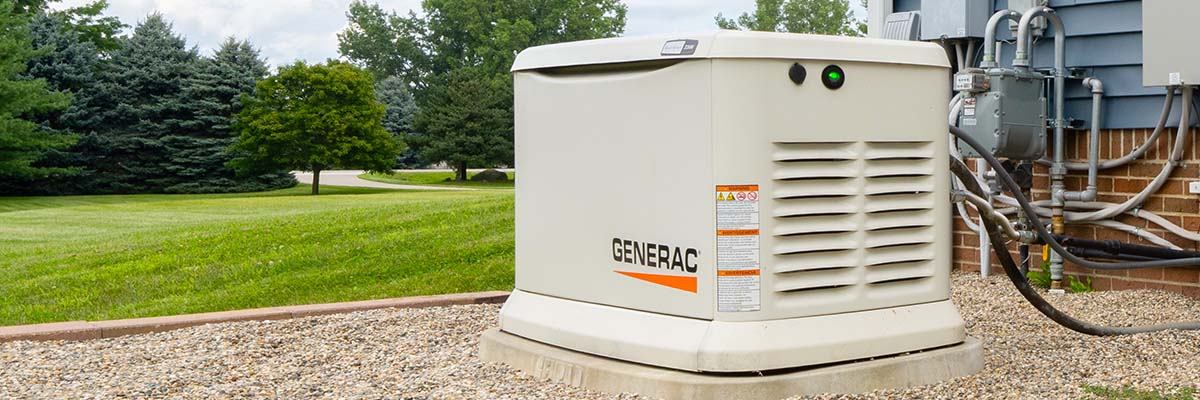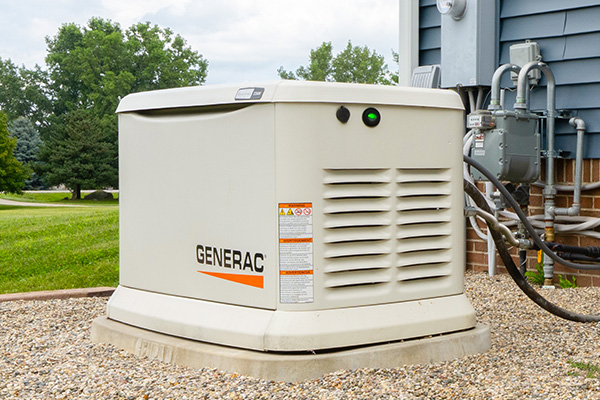

Standby Generators Do More Than Keep the Lights On
Storms and extreme weather can make the power to your home unpredictable. You have a portable generator, but is it time to upgrade to a whole-home generator? A whole house generator (sometimes called a standby generator) is a unique, modern option for battling the unpredictability of Mother Nature. Here's why you might consider having this type of standby generator before the next storm rolls through.
What is a Standby Generator?
A standby generator has many unique differences from a portable generator.
- First, a standby generator offers (nearly) permanent backup power and auto-starts when power is lost. This means no pull cord is needed.
- Next, a standby generator typically runs on natural gas or propane (not gasoline, like most portable generators). And it can power more appliances than a portable generator can. If you've ever had to make hard decisions on running the air conditioning or the refrigerator during a long power outage, then you might consider a standby generator for your home.
- A standby generator also comes with a higher upfront cost and requires professional installation. Since it's wired into your home's electrical system, you'll want to make sure that your standby generator won't damage any appliances.
By comparison, a portable generator is often a small, compact machine, you see (and definitely hear) outside, when connecting to a standard electrical grid isn't an option. They often run on gasoline, and you should always operate them outdoors for proper ventilation, which means a minimum of 20 feet away from a home. Learn more about how a portable generator works and basic safety tips.
Standby Generator Basics
Here's the minimum of what you need to know about standby/whole-home generators.
- Installation: Use a licensed electrician, certified generator installer, or dual-certified contractor to install your standby generator properly. This will include installing the generator itself, an appropriate fuel tank outside your home, and the connections to your home's electrical system.
- Maintenance: Always follow the manufacturer's guidelines for maintenance on your standby generator. Most require you to shut them completely off after each 24-hour run time. In 10-15 minutes, you can cool down the generator, check fluid levels, and ensure the system is in good working order. Monthly maintenance is also key, be sure to check oil and coolant levels and run a test cycle.
- Safety: If your generator is properly installed and maintained, you are already well on your way to operating safely. A serious piece of equipment, generators should operate only outside the home, not indoors, as they emit fumes that could be harmful. In addition, ensure that proper shutdown procedures are taken when needed. This includes not shutting down a standby generator while it’s “under load” but instead disconnecting and shutting it down properly, which will ensure your generator remains in good condition. Make sure you have battery-powered carbon monoxide detectors in your home.
Differences Between Standby and Portable Generators
If you're weighing the differences between portable generators and standby generators, this quick breakdown could help you make the decision.
| Standby Generator | Portable Generator |
|---|---|
| Higher upfront costs | Lower upfront costs |
| Requires professional installation | Self-installation |
| Auto-starts after detecting a power outage | Requires a physical pull cord or electric start |
| Can run for 24 hours, inspected, then restarted for a run-time of up to three weeks | Run for an average of 6-16 hours, depending on fuel tank type and size |
| Use 13 to 48 gallons of liquid propane or natural gas per day | Can use 12 to 20 gallons of gasoline per day |
| Designed to power your whole home, 8,000 to 20,000 watts | The amount of power output depends on the type and size of the portable generator, starting at around 2,000 watts |
| Permanent installation | Portable use where you need it (and store it away when you don't) |
How to Choose the Right Type of Generator
There are ways to make your generator choice easier, and they start with a few questions you should consider.
Consider How Often You Lost Power
- How often do you tend to have power outages? And for how long?
- Do you have medical needs that require you to run appliances like a refrigerator or air conditioning or even medical equipment all the time?
- Are you physically able to manually start a portable generator
Next, Think About the Costs
- Portable generators start in the hundreds for the most basic models.
- Standby home generators can cost several thousand dollars, plus professional installation.
Finally, How Will It Impact Your Home or Your Long-Term Plans?
- Standby generators must be permanently installed outside your home, along with their fuel tank. Will you (or your HOA) mind that?
- Portable generators can be stored when not in use or taken to other locations as needed.
McCoy's Has What You Need to Keep the Lights On
At McCoy's, our experts don't like leaving anyone in the dark. That's why we have the tools and advice needed to keep comfortable, no matter what Mother Nature tries to throw our way. From standby home generators to a portable generator ready for a fun weekend, we're prepared to step up when you need the best.
